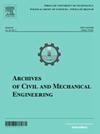A comprehensive study on vibration and loss characteristics of MR doubly curved sandwich panels with CNT-reinforced FGP face sheets
Abstract
This study supplies a comprehensive exploration of the vibrational response of an advanced doubly curved sandwich panel resting on the Winkler–Pasternak elastic foundation, uniquely designed with a magnetorheological (MR) core and functionally graded piezoelectric (FGP) face sheets enhanced by diverse configurations of carbon nanotubes (CNTs). A power law function is employed to accurately characterize the distribution of FGP properties across the thickness of the face sheets. The micromechanical approach is adopted to derive the equivalent properties of the reinforced FGP layers, considering five distinct CNT distribution patterns as unique reinforcement strategies. The governing equations of the smart sandwich structure under the electric field impact are formulated based on first-order shear deformation theory (FSDT) by implementing Hamilton’s principle. Subsequently, the numerical results are obtained based on Navier’s technique for fully simply supported boundary conditions, utilizing a double-Fourier series. The reliability and efficacy of the suggested theoretical framework are validated through a comparative analysis of the available results. Eventually, a comprehensive study is conducted to examine various influential parameters on the natural frequency and loss factor of the doubly curved smart sandwich structure. The findings highlight that increasing the volume fraction of CNTs and the intensity of the applied magnetic field significantly influence the static stability of the rheological sandwich plate. This study not only provides benchmark solutions for engineering applications but also lays the groundwork for the future development of semi-active devices with tunable stiffness.

 求助内容:
求助内容: 应助结果提醒方式:
应助结果提醒方式:


